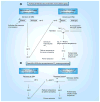COLD-PCR: improving the sensitivity of molecular diagnostics assays
- PMID: 21405967
- PMCID: PMC3111913
- DOI: 10.1586/erm.10.115
COLD-PCR: improving the sensitivity of molecular diagnostics assays
Abstract
The detection of low-abundance DNA variants or mutations is of particular interest to medical diagnostics, individualized patient treatment and cancer prognosis; however, detection sensitivity for low-abundance variants is a pronounced limitation of most currently available molecular assays. We have recently developed coamplification at lower denaturation temperature-PCR (COLD-PCR) to resolve this limitation. This novel form of PCR selectively amplifies low-abundance DNA variants from mixtures of wild-type and mutant-containing (or variant-containing) sequences, irrespective of the mutation type or position on the amplicon, by using a critical denaturation temperature. The use of a lower denaturation temperature in COLD-PCR results in selective denaturation of amplicons with mutation-containing molecules within wild-type mutant heteroduplexes or with a lower melting temperature. COLD-PCR can be used in lieu of conventional PCR in several molecular applications, thus enriching the mutant fraction and improving the sensitivity of downstream mutation detection by up to 100-fold.
Figures






Similar articles
-
Coamplification at lower denaturation temperature-PCR increases mutation-detection selectivity of TaqMan-based real-time PCR.Clin Chem. 2009 Apr;55(4):748-56. doi: 10.1373/clinchem.2008.113381. Epub 2009 Feb 20. Clin Chem. 2009. PMID: 19233916 Free PMC article.
-
Temperature-tolerant COLD-PCR reduces temperature stringency and enables robust mutation enrichment.Clin Chem. 2012 Jul;58(7):1130-8. doi: 10.1373/clinchem.2012.183095. Epub 2012 May 15. Clin Chem. 2012. PMID: 22587896 Free PMC article.
-
COLD-PCR-enhanced high-resolution melting enables rapid and selective identification of low-level unknown mutations.Clin Chem. 2009 Dec;55(12):2130-43. doi: 10.1373/clinchem.2009.131029. Epub 2009 Oct 8. Clin Chem. 2009. PMID: 19815609 Free PMC article.
-
COLD-PCR: a new platform for highly improved mutation detection in cancer and genetic testing.Biochem Soc Trans. 2009 Apr;37(Pt 2):427-32. doi: 10.1042/BST0370427. Biochem Soc Trans. 2009. PMID: 19290875 Review.
-
Co-amplification at lower denaturation temperature-PCR: methodology and applications.Yi Chuan. 2018 Mar 20;40(3):227-236. doi: 10.16288/j.yczz.17-369. Yi Chuan. 2018. PMID: 29576546 Review.
Cited by
-
COLD-PCR enrichment of rare cancer mutations prior to targeted amplicon resequencing.Clin Chem. 2012 Mar;58(3):580-9. doi: 10.1373/clinchem.2011.176198. Epub 2011 Dec 21. Clin Chem. 2012. PMID: 22194627 Free PMC article.
-
Enzymatic Methods for Mutation Detection in Cancer Samples and Liquid Biopsies.Int J Mol Sci. 2023 Jan 4;24(2):923. doi: 10.3390/ijms24020923. Int J Mol Sci. 2023. PMID: 36674433 Free PMC article. Review.
-
Pyrimidine-Dependent UV-Mediated Cross-Linking Magnifies Minor Genetic or Epigenetic Changes in Clinical Samples.Clin Chem. 2024 Sep 3;70(9):1151-1161. doi: 10.1093/clinchem/hvae086. Clin Chem. 2024. PMID: 39039866 Free PMC article.
-
COLD-PCR amplification of bisulfite-converted DNA allows the enrichment and sequencing of rare un-methylated genomic regions.PLoS One. 2014 Apr 11;9(4):e94103. doi: 10.1371/journal.pone.0094103. eCollection 2014. PLoS One. 2014. PMID: 24728321 Free PMC article.
-
Nuclease Enrichment and qPCR Detection of Rare Nucleotide Variants.Methods Mol Biol. 2023;2621:41-56. doi: 10.1007/978-1-0716-2950-5_4. Methods Mol Biol. 2023. PMID: 37041439
References
Websites
-
- MeltSim: The DNA Melting Simulator. www.bioinformatics.org/meltsim/wiki.
-
- Institut für Physikalische Biologie. www.biophys.uni-duesseldorf.de/local/POLAND/poland.html.
Publication types
MeSH terms
Substances
Grants and funding
LinkOut - more resources
Full Text Sources
Other Literature Sources
